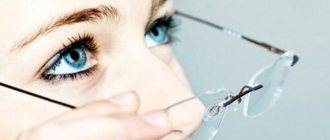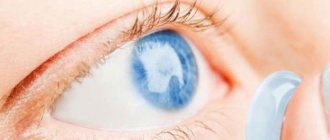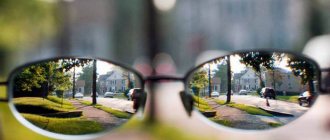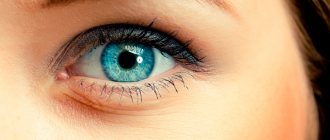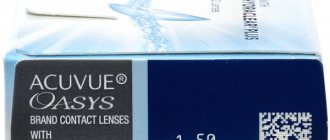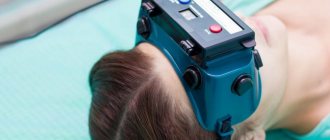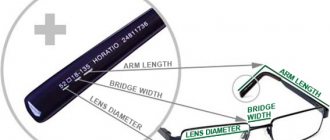Astigmatism, along with myopia and farsightedness, is a refractive pathology of the eye and is one of the main causes of decreased visual acuity, especially at a young age. The reason for this is disturbances in the refractive optical system of the eye.
As you know, astigmatism is a different refraction of the cornea of the eye in two different meridians. In this case, ordinary biconvex glasses are not able to completely correct vision. And ophthalmologists prescribe special cylindrical glasses. What are they?
The need for glasses for astigmatism
There are different types of disease. It can appear immediately after birth, be hereditary or acquired. There may be a slight distortion in the perception of the picture, which is in the area of less than 0.75 diopters. In this case, a person sees blurred surrounding objects, their shape and size are distorted. To correct deficiencies, you can use special glasses.
There are the following types of glasses cut:
- spherical (aimed at correcting visual acuity);
- cylindrical (aimed at correcting astigmatism).
We recommend reading: Comparison of spherical and aspherical lenses
It is prohibited to use ordinary optical models to disrupt the perception of objects. This can lead to irreparable complications. In this case, you will need to select difficult glasses.
If the disease develops in early childhood, the only method of vision correction is glasses. Laser surgery is applicable only after reaching the age of 18. When your child goes to school, you can try using lenses.
The type of astigmatism does not affect the need to wear glasses. They can be used for mild or severe cases. In this case, the doctor will adjust the shape of the lenses for the glasses, select their thickness and material of manufacture.
Treatment of astigmatism
There are three ways to treat astigmatism:
- 1. Glasses with cylindrical lenses.
- 2. Astigmatic contact lenses.
- 3. Laser surgery.
Laser vision for astigmatism is performed on an outpatient basis within 10-15 minutes. A microkeratome is used to cut the corneal layer and fold back the separated flap. Access is opened for a laser beam, which evaporates part of the corneal stroma, and the flap returns to its original place. After the operation, no stitches are required, which makes the recovery period very short. The surgical method corrects astigmatism only up to 3.0 D.
Pros and cons of correction with glasses
The use of glasses for illness has many advantages for the patient:
- correction of visual acuity with glasses;
- painlessness (unlike glasses, lenses often cause discomfort on the mucous membrane of the eyes);
- safety to wear, especially if the lens is made of polymer plastic;
- low cost, availability of various models;
- elimination of concomitant pain syndromes that often occur with the disease (eye fatigue, headaches).
Many patients use other types of vision correction, since glasses for them have the following negative aspects:
- a long period of adaptation, which results in severe pain in the eyes and head, decreased visual acuity;
- the ability to see objects that are only in front of the eyes, lateral vision is limited;
- the risk of cracks, scratches on the lenses, and breakage of the plastic frame increases;
- In rain, fog, and snowfall, the ability to wear glasses is limited, as they sweat and become wet.
If glasses are not suitable for the patient, the doctor may prescribe contact lenses or laser surgery. The first option can be used by children who have already reached the age of 7-8 years. Laser surgery is prescribed only after reaching the age of 18, since before this moment the shape and structure of the eyes can change. Therefore, if the patient had surgery at an early age, the risk of relapse of the disease increases.
Plastic or glass?
Since the child cannot adequately assess the acuity of his vision, the choice of glasses falls on the shoulders of the parents. The main stumbling block is what the optics should be: plastic or glass lenses?
For active kids who spend most of their time in energetic games, unbreakable, non-traumatic plastic is preferable, making the glasses light and comfortable to wear. Plastic lenses must have a mandatory hardening layer to prevent scratches that distort the optical parameters of the glasses. High-quality plastic has a high refractive ability with a small thickness of the lens itself.
How to choose
In order to select the optimal structure of lenses necessary for impaired perception of objects, you must first consult with an ophthalmologist. Buying glasses on your own will lead to a deterioration in the patient’s health, headaches and decreased visual acuity.
After the initial examination, the doctor will prescribe the following diagnostic measures:
- checking visual acuity, for which special tables are used, according to which a person tells what letters he sees;
- fundus examination to examine the retina and lens;
- using an autorefractometer to study the passage of a light beam through the internal structure of the eyes;
- Ultrasound of the organs of vision;
- corneal examination;
- measurement of intraocular pressure.
Only after carrying out diagnostic measures can the doctor determine what thickness the lenses should be and the material of manufacture.
Choosing lenses for glasses
For nearsightedness or farsightedness, stigmatic glasses are used. With their help, the light beam is coordinated in the center and directed through the pupil into the retina.
If the patient has a violation of the passage of the light beam, use 2 types of glasses.
- Cylindrical glasses for astigmatism. They are used when light perception is impaired in only one meridian.
- Toric glasses. They are used for impaired light perception in both meridians.
This is the basic structure of glasses; at the patient’s request, additional functions can be selected for them:
- reduction in thickness using polymer glass, which maintains functionality;
- chameleon glasses, which darken in the sun and lighten in the shade, which helps reduce eye strain from bright light;
- the use of durable materials that do not break upon impact;
- no glare formation.
Frame selection
When selecting glasses, you can choose the cheapest frame, but this will mean that wearing comfort is reduced.
For a certain surcharge, you can order a special frame that will meet the following criteria:
- the frame should extend along the entire perimeter of the lens, as this facilitates the correct passage of the light beam through the model;
- the frame for the lenses should be medium, not large and not wide, as this can cause distortion of perception at the edges;
- in case of illness, it is necessary that the edges of the glasses are at the level of the temples;
- The bottom of the frame should be higher than the bottom line of the nostrils.
Wearing glasses will worsen your vision.
Usually in such a situation I remember someone who started wearing glasses and then their vision only worsened. Everyone who ate cucumbers in the 16th century all died. Are cucumbers poison?
Typically, such observations are characteristic of myopia. Myopia tends to begin at a young age and progress quickly or slowly during adolescence. Even a slight degree of myopia leads to decreased vision and the need for glasses or contact lenses quickly arises.
It is common for myopia to progress in childhood and adolescence and then it stops. People attribute the deterioration to wearing glasses. However, if the problem of progressive myopia could be solved by eliminating glasses, or not prescribing glasses, then everything would be just fine.
Myopia increases both with and without glasses. In addition, according to some researchers, it’s faster without glasses.
The increase in myopia and the fact that glasses were prescribed are connected only by the fact that they coincide in time. Myopia increases in childhood and adolescence, and glasses are prescribed at the same time. There is no other connection.
In case of farsightedness and astigmatism, glasses prescribed in a timely manner contribute to the fact that vision, on the contrary, becomes higher, since glasses contribute to the natural development of vision, which can stop due to the fact that an anomaly in the optics of the eye does not allow the surrounding world to be clearly focused on the retina.
It should be noted that the eye can actively focus only in the case of farsightedness and a normal optical system of the eye. With myopia, the eye is focused (due to myopia itself) at near, and accommodation, which can only be actively tuned to near, is not involved.
The eye cannot focus into the distance and it is impossible to “train” it for this process; it simply does not have the mechanisms to focus into the distance. In other words, the eye does not work with myopia; it will work if the optics of the eye change to normal or to weak myopia (for example, with the help of glasses).
The ciliary muscle, which changes the curvature of the lens, thanks to which the eye focuses, differs in its structure from the skeletal muscles that are trained in the gym; it is simply impossible to pump it up and force it to work beyond its capabilities. This is why we are always skeptical about any gymnastics for accommodation.
Important
In addition, the lens itself does not actively contract with muscles, but only changes its curvature, due to the fact that the muscle relaxes the threads on which it is attached, releases it, and the lens contracts itself due to its elastic properties.
The statement itself: “the eye must work on its own” is not based on knowledge of the anatomy and physiology of the eye and, again, does not end with any conclusions.
Manufacturers and prices for spectacle lenses
There are manufacturers that produce the most successful and cheapest models of glasses for astigmatists:
- Zeiss;
- Glance;
- Sola.
The starting price of such models is from 800 rubles. It includes the simplest glass and frame. If a person has a high degree of disease or wants to add specific features to the models, this increases the cost. The most expensive models (from 1,500 rubles) are presented by the following companies:
- Hoya;
- Indo.
The more additional parameters the patient wants to use, the more expensive the optical models will be.
What is better - lenses or glasses?
Some people are embarrassed to wear astigmatic glasses and therefore prefer contact lenses, which have a number of advantages:
- correct corneal astigmatism;
- no changes in the field of view;
- the prismatic effect is almost absent;
- guarantee good vision with both eyes.
But contact lenses for constant wear are still inferior to eyepieces, as they have significant disadvantages:
- can cause complications, development of inflammatory processes;
- contribute to the progression of myopia;
- provoke changes in the shape and topography of the cornea;
- require long-term adaptation and cause discomfort.
In addition, lenses are more expensive than glasses and can easily get lost. Most doctors recommend correcting astigmatism using eyepieces, but the choice of correction method remains up to the patient.
Having received a sad diagnosis, each patient begins to wonder what is better: glasses correction or special contact lenses? Glasses for astigmatism have both their advantages and disadvantages. The undeniable advantages include:
- Glasses not only correct a corneal defect, but also have a therapeutic effect.
- One device is enough to see clearly both at close and long distances.
- If the lenses are chosen correctly, your eyes will not get tired even after wearing them for many hours, working at a computer or driving a car.
- Glasses are affordable and safe.
- Provided that the correct frame and adequate lenses are used, the image does not double, the perspective and contours of objects are not distorted.
Spectacle correction is considered the simplest and most convenient. But this method also has its drawbacks. These include:
- It will take quite a long time to adapt. In the first week, glasses with weaker lenses are put on immediately after sleep for several hours. If everything is in order, the wearing time is gradually increased. After a few more weeks, the lenses are changed to stronger ones, and the process of gradual adaptation is repeated.
- It is often not possible to choose the right lenses and frames the first time. If after the first or second week of the adaptation period the visual distortions do not go away, the patient experiences visual discomfort, headaches, and the frame will need to be adjusted or other glasses selected.
- It is difficult for elderly patients to get used to such glasses. Sometimes discomfort, headaches and dizziness do not disappear even after several months.
- Glasses fog up when temperature conditions change; it is not always convenient to wear them outdoors, for example, in rain or snow.
- The frame may break or become deformed, and then you will need to spend time and money on repairs or choose a new one.
- Children often break and constantly lose their glasses; such devices do not allow them to engage in some sports and play active games.
- Glasses change the patient's appearance, which is extremely important for some. And although today for many they are, on the contrary, a stylish part of the image, there are also many who flatly refuse to wear them.
https://www.youtube.com/watch?v=y9nFVi4I3Wc
In some cases, usually with complex, mixed astigmatism, even young patients still fail to get used to astigmatic lenses. They are worried about constant headaches, rapid eye fatigue, and discomfort with prolonged eye strain. Therefore, the decision on the advisability of using spectacle correction is always decided individually, jointly by the doctor and the patient.
If you have a high degree of astigmatism or intolerance to glasses, you have to choose other means of correction. Toric contact lenses are popular today. They are able to correct the main refractive error and concomitant pathology. Modern models of contact optics with a toric design quickly stabilize on the eyeball and do not move even during intense physical activity. Which contact lenses to choose? We list some models that ophthalmologists recommend:
- Biofinity Toric from CooperVision. These lenses are produced using Aquaform technology and are 48% moisturized.
- PureVision 2 HD for Astigmatism from Bausch Lomb are products that guarantee high quality vision even during sports.
For some people, due to intolerance to lenses and glasses, their eyes become tired, red, and watery. Headaches and dizziness occur. In such cases, laser vision correction can be performed, during which the curvature of the cornea is corrected and its refractive power is changed. After this operation you will no longer have to wear glasses. They will be needed only after 40 years, when the first signs of presbyopia appear.
Another alternative to glasses for astigmatism is hard night lenses. They are placed on the eyes before bedtime, during which they correct the shape of the cornea. Throughout the day, a person can do without correction means.
Many people ask this question because they are embarrassed to wear astigmatic glasses.
Optical devices that do not have a frame and are inserted directly into the eye undoubtedly have their advantages. They:
- guarantee higher visual acuity due to the fact that they are placed directly on the cornea of the visual organ;
- do not cause transformation of visual fields;
- guarantee good visual perception with both eyes;
- and practically eliminate the presence of a prismatic effect when used.
However, contact lenses for regular wear if the patient has astigmatic disease are not entirely suitable, since they also have disadvantages:
- they are quite difficult to select;
- can provoke complications and cause inflammation in the eye;
- contribute to the progression of myopia;
- contribute to changes in the appearance of the cornea;
- require a long time to get used to, cause discomfort with constant wear;
- need regular replacement and acquisition of special donning skills.
In addition, contact lenses are often significantly more expensive than regular corrective glasses. Soft lenses are so thin and fragile that they can easily break. For this reason, ophthalmologists advise correcting a visual defect using eyepieces rather than lenses. However, the final choice of correction method always remains with the patient.
To summarize, it is worth mentioning that correctly selected eyepieces are a guarantee of optimal and convenient correction of distorted visual perception of observed objects. However, this method of correction requires certain financial and time costs. Early optical correction guarantees the patient a reduced risk of developing complications due to the existing disease, including a sharp decrease in vision and the appearance of strabismus. If it is completely ineffective, the patient is recommended to resort to laser surgery.
Getting used to glasses
Since the disease changes the structure of the eyes, this causes additional discomfort when starting to use optical models. Sensitivity increases with age. Therefore, it is recommended to use glasses immediately after diagnosis in early childhood.
After starting use, the patient experiences the following symptoms:
- decreased visual acuity;
- fatigue after prolonged wearing;
- headache, dizziness when concentrating.
Many patients believe that for successful adaptation it is necessary to wear optical models for short periods. But that's not true. For the fastest possible adaptation, corrective glasses are used continuously. If after 2 weeks the unpleasant symptoms do not go away, you should consult a doctor. Perhaps the glass model was selected incorrectly.
If your child is prescribed glasses
Parents often doubt whether their child should wear glasses because they will worsen their vision. This fear is probably based on the fact that a person who starts wearing glasses notices after a while that without glasses he begins to see worse than before.
However, this is not due to the negative effect of glasses on the eyes, but to the characteristics of the brain. With small degrees of astigmatism and other diseases, a person may not notice vision problems due to excessive tension in the ciliary muscle of the eye.
From such stress, vision improves, but the brain gets tired. Fatigue and headaches may occur.
This ability of the body to adapt is quite high in childhood, but decreases with age. When a person puts on glasses and vision improves without overstraining the ciliary muscle, the brain seems to “relax.” He no longer tries with all his might to compensate for low vision.
Refusal to wear glasses in childhood can have a very negative impact on health. It is necessary to understand that they are a therapeutic measure. Without correction, eye development slows down. Only with glasses does the child see a clear, not blurry image.
Reviews from doctors
Marina, ophthalmologist: Many of my patients suffer from astigmatism. This is a visual impairment in which objects are seen in a distorted form. If the disease was discovered in early childhood, I recommend wearing glasses. This is the gentlest correction method. Upon reaching the age of 20-25, I advise you to use laser correction.
Vlad, ophthalmologist: I have patients who did not know that they had astigmatism and started wearing regular corrective glasses. This led to complications. In this case, I advise you to immediately switch to special optical models that completely eliminate headaches and eye fatigue.
Advantages and disadvantages
The advantages of spectacle correction include:
- ease of use;
- relatively low cost.
- embarrassment when wearing glasses due to aesthetic discomfort;
- glasses help reduce the viewing angle and thereby disrupt spatial perception, which is a big disadvantage for drivers. If the frame is selected incorrectly, headaches, fatigue, or a significant decrease in performance may occur;
- It is difficult to combine wearing glasses with active recreation or playing sports;
- With the help of glasses it is not always possible to achieve the highest levels of visual acuity;
- If glasses fall, they can cause serious damage to the eyeball;
- There are certain difficulties with the selection of lenses. The fact is that if they are chosen incorrectly, disease progression occurs (astigmatism, myopia, hypermetropia).
Consumer Reviews
Diana: My son has had blurred vision since childhood. Before school, we started examining him and went to an ophthalmologist. After the diagnosis, the doctor said that my son had astigmatism. Prescribed special glasses. Now he sees well and has no headaches.
Olga: I am 24 years old, of which I have been wearing glasses for 15 years. This is due to the fact that the doctor discovered that I have astigmatism. I will undergo laser surgery soon. The doctor said that after it, my vision would be completely restored and I wouldn’t need to wear glasses.
